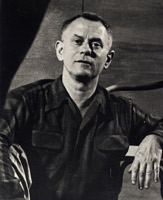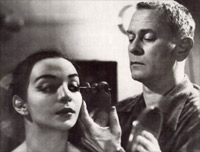Opening
Program  Program
I Program
I  Program
II Program
II  Program
III Program
III  Program
IV Program
IV  Program
V Program
V  Program
VI Program
VI  Program
VII Program
VII  Program
VIII Program
VIII  Program
IX Program
IX  Program
X Program
X  Program
XI Program
XI  Russian
Dance Film Competition Russian
Dance Film Competition  Closing Program
Closing Program

Program
IV: Dance History: Lester Horton

Photo
by Charles Van Manaan |
"Although
less known in Russia, dancer-teacher-choreographer Lester
Horton (1906-1953) is regarded as one of the
founders of American modern dance. He developed a unique style
of technique and choreography, established the first permanent
theater in America devoted to dance, and organized one of the
first integrated modern dance companies.
Born and raised in Indiana, Horton's early interests in art,
ballet, theater production, and Native American dance led him
to participate in local dance pageants. Settling in Los Angeles
in the late 1920s, Horton danced with Michio Ito's company and
then formed his own group. His company gave concert performances
at major Los Angeles venues such as the Hollywood Bowl and the
Greek Theater while Horton continued to teach young dancers.
A Los Angeles base and the ability to translate ethnic dances
into commercially acceptable formats led to stints choreographing
musical numbers for films from the 1940s through the early 1950s.
Throughout his career, Horton combined dance and drama into
a total theatrical experience. He was intimately involved in
creating all aspects of a production: the costumes, sets, lighting,
and music as well as the scenarios and choreography. His fascination
with ethnic dance, human sensuality, and cultural history was
expressed in a prodigious body of work with themes ranging from
the classics to melodrama, social concerns to farce. Horton's
"choreodramas" were built on a movement technique
that is still taught and used in dance schools and companies.
Horton's
company members and students included well-known modern dancers
such as Alvin Ailey, Janet Collins, Carmen de Lavallade, Bella
Lewitzky, James Mitchell, Joyce Trisler, and James Truitte.
Horton collaborated with Lewitzky to develop the foundation
of his technique; they joined forces with several other partners
to found the Dance Theater in Hollywood in 1946. Dance Theater
was the home of the dance company and the school, which featured
dance classes for children and adults. The full curriculum developed
well-rounded dancers who were also taught art history and theater
production. After the partnership dissolved in 1950, Horton
maintained Dance Theater with the assistance of business manager
Frank Eng, mounting several successful seasons until his death
in 1953. Eng sustained the theater for seven more years before
closing its doors in 1960." - LIbrary of Congress
“Genius
on the Wrong Coast”
90min,
1993, USA
Director: Lelia Goldoni
Dancers: Lester Horton Dance Theatre
 Photo
by Charles Van Manaan
Photo
by Charles Van Manaan |
This vivid
documentary is a portrait of Lester Horton, his life and career.
Interviews with the Horton's disciples (from the filmmaker herself
to Alvin Ailey) and members of Lester Horton Dance Theatre,
dance historian, critics, and friends are intertwined with archival
photographs and footage capturing the moments from the master's
life.
Lelia
Goldoni has
been producing films and plays since 1990. As a teenager, she
danced with Alvin Ailey, Carmen de Laballade and finally at
the famed Lester Horton Dance Theatre on Los Angeles. This experience
was life informing and has stayed with her for her whole life.
In 1955, Lelia began studying acting and soon after moved to
New York to join John Cassavetes' theatre group. In 1957, she
made her first screen debuts in Cassavetes' ground-breaking
film Shadows for which she was nominated for the British
Academy Award. For the next 12 years, she continued her career
in England when she enjoyed a string of acting success in such
features as Tennessee Williams' Rose Tattoo, Dawn,
A Dream Divided and many others. She continued acting in
Hollywood upon her return in the mid 1970s. She has also became
a teacher and taught acting at the University of California
in Los Angeles, Stanford University, New York University and
others.
Opening
Program  Program
I Program
I  Program
II Program
II  Program
III Program
III  Program
IV Program
IV  Program
V Program
V  Program
VI Program
VI  Program
VII Program
VII  Program
VIII Program
VIII  Program
IX Program
IX  Program
X Program
X  Program
XI Program
XI  Russian
Dance Film Competition Russian
Dance Film Competition  Closing Program
Closing Program
© Kinodance–Russia, 2004
akovgan@kinodance.com
|
|

